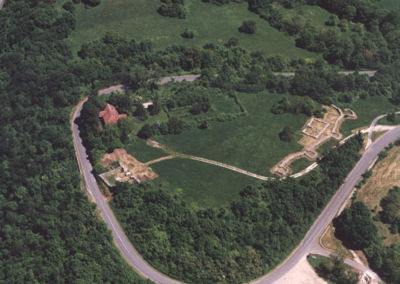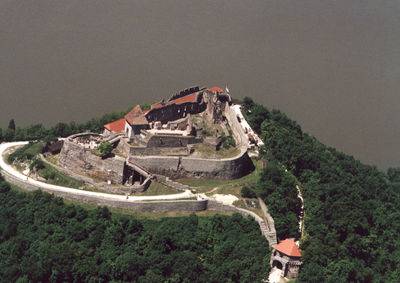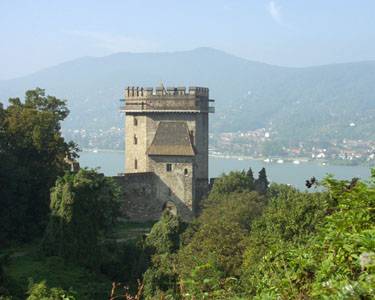 |
 |
|
SOCIAL EVENTS The social event will be in the afternoon on 22 September 2006. Links: http://en.wikipedia.org/wiki/Visegr%C3%A1d
History of Visegrád Visegrád (German: Plintenburg) is a small town in Pest County in Hungary with a long and rich history. Situated north of Budapest on the right bank of the Danube in the Danube Bend, the town has a population 1,654 as of 2001. Visegrád is famous for the remains of the early Renaissance summer palace of Matthias Corvinus and the medieval Citadel. Name Visegrád is Slavic by origin and means "the high city". There is a town with same name in present-day Bosnia and Herzegovina (see: Višegrad). Visegrád was first mentioned in 1009 as a county town and chief town of archdeaconry. After the destructive Mongol invasion in 1242, the town was rebuilt in a slightly different location to the south. King Charles I of Hungary made Visegrád, his hometown, the royal seat of Hungary in 1325. In 1335, Charles I of Hungary hosted a two-month congress held at Visegrád, with other the Bohemian king John of Luxembourg, and the Polish king, Casimir III. It was crucial in creating a peace between the three, and securing an alliance between Poland and Hungary against the Habsburgs. Later, Sigismund, Holy Roman Emperor (and also king of Hungary) moved the royal seat to Buda between 1405-1408, then Matthias Corvinus of Hungary used Visegrád again as a country residence. Visegrád lost importance when the medieval Hungarian state fell into three pieces as a consequence of the Ottoman Turkish occupation. In 1991, the leading politicians of Hungary, Czechoslovakia, and Poland met here to form a periodical forum between these countries, the Visegrád group, with an intentional allusion to the meeting centuries earlier in 1335. Visegrád was granted town status in 2000.
Monuments of Visegrád Sibrik Hill (Roman military camp and 11th-century castle):
The ruins of this military camp can be seen outside Visegrád, to the north, on a hill that overlooks the Danube. The camp has a triangular ground plan. It was built in the first half of the 4th century as one of the important fortifications along the limes, the frontier of the Roman Empire. Its praetorium (the commander's building) was construction at the end of the 4th century. In the early 5th century, the Roman Army abandoned the military camp. In the 10th and 11th centuries, the renovated fortification became a regional centre of the recently formed Hungarian State. The name "Visegrád" appears at this time (1009) for the first time as the name of this regional centre. The fortification was finally destroyed in 1242 by the Mongol invasion. Aerial photography: Sibrik Hill
Upper Castle or "Citadel" (13-15th centuries):After the Mongol invasion, King Béla IV and his wife had a new fortification system constructed in the 1240-50s near the earlier, destroyed one. The first constructed part of the new system was the Upper Castle on top of a high hill. The castle was laid out on a triangular ground plan and had three towers at its corners. In the 14th century, at the time of the Angevin kings of Hungary, the castle became a royal residence and was enlarged with a new curtain wall and palace buildings. Around 1400 King Sigismund of Luxembourg also had a third curtain wall constructed and enlarged the palace buildings. At the end of the 15th century, King Matthias Corvinus of Hungary had the interior part of castle renovated. The Upper Castle also served for the safekeeping of the Hungarian Royal Insignia between the 14th century and 1526. In 1544 it was occupied by the Ottoman Turks, and - apart from a short period in 1595-1605 - it remained on Turkish hands until 1685. The castle was seriously damaged by the Turks and was never used afterwards. The castle is now open to the public for visit.
Aerial photography: Visegrád Mountain Fastness
Lower Castle or "Solomon Tower" (13th century; Museum):The Lower Castle is the part of the fortification system that connects the Upper Castle with the Danube. In its centre rises the Solomon Tower, a large, hexagonal residential tower dating from the 13th century. In the 14th century, new curtain walls were built around the tower. During a Turkish raid in 1544, the southern part of the tower collapsed. Its renovation began only in the 1870s and finished in the 1960s. At present, the Tower houses exhibitions installed by the King Matthias Museum (Mátyás Király Múzeum) of Visegrád. The exhibitions present the reconstructed Gothic fountains from the Royal Palace, Renaissance sculpture in Visegrád, and the history of Visegrád.
Aerial photography: "Solomon Tower"
Royal Palace or the "Palace of Matthias Corvinus of Hungary" (14-15th centuries, Museum):The first royal house on this site was built by King Charles I of Hungary after 1325. In the second half of the 14th century, this was enlarged into a palace by his son, King Louis I of Hungary. In the last third of the 14th century, King Louis and his successor Sigismund of Luxembourg had the majority of the earlier buildings dismantled and created a new, sumptuous palace complex, the extensive ruins of which are still visible today. The palace complex was laid out on a square ground plan measuring 123 x 123 m. A garden adjoined to it from the north and a Franciscan friary, founded by King Sigismund in 1424, from the south. In the time of Louis I and Sigismund the palace was the official residence of the Kings of Hungary until about 1405-08. Between 1477-84 King Matthias Corvinus had the palace complex reconstructed in late Gothic style, but in the decoration of the architectural parts also the Italian Renaissance style was used, which appeared here for the first time in Europe outside Italy. After the Ottoman Turks' siege in 1544 the palace fell into ruins, and by the 18th century it was completely covered by earth. Its excavation began in 1934 and continues to our days. At present, the reconstructed royal residence building is open to the public, and houses exhibitions on the history of the palace and reconstructed historical interiors. Aerial photography: Royal Palace |
|
© Copyright 2006 BUTE. All Rights Reserved.



